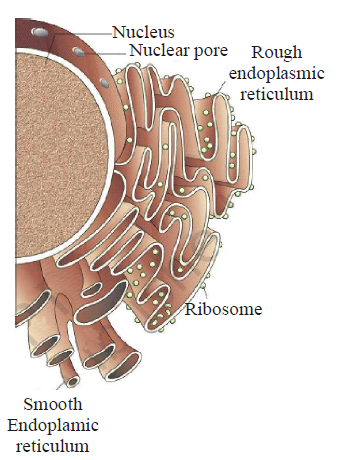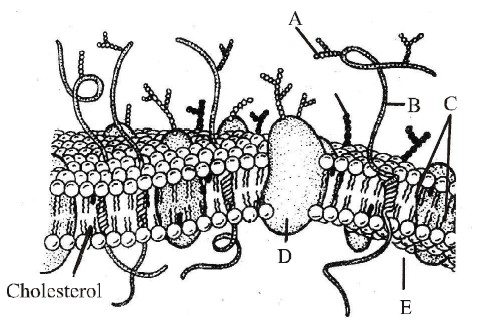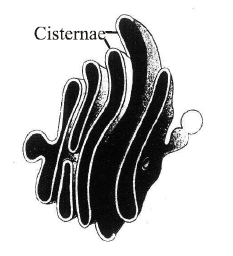Statement 1: Centrosomes and centrioles are related to each other.
Statement 2: Centrosome usually contains two cylindrical structures called centrioles.
Both statements -1 and statement - 2 are true and statement - 2 is the correct explanation of statement - 1.
Both statements -1 and statement - 2 are true but statement - 2 is not the correct explanation of statement - 1.
Statement -1 is true and statement - 2 is false.
Statement -1 is false and statement - 2 is true.
Correct Answer :
A. Both statements -1 and statement - 2 are true and statement - 2 is the correct explanation of statement - 1.
The centrosome (occur only in animals cells) is the main place where cell microtubules get organized. Centrosome usually contains two cylindrical structures called centrioles. Centrioles are composed of groupings of microtubules arranged in a 9 + 3 pattern. The pattern is so named because a ring of nine microtubule triplets are arranged at right angles to one another. Centrioles, found in animal cells, help to organize the assembly of microtubules during cell division. Centrioles replicate during the interphase stage of mitosis and meiosis.
Related Questions
Which of the following statement is false?
The ribosomes of a polysome translate the mRNA into protein.
Mitochondria divide by fragmentation.
All cell arise from pre-existing cells.
The lipid component of the membrane mainly consists of phosphoglycerides.
You are asked to examine a cell using a powerful light microscope. The image you see has a clearly defined nucleus and mitochondria. It also has a large central vacuole and chloroplasts. From what group of organisms did this cell most likely come?
Bacteria
Protists
Fungi
Plants
The lipid component of the membrane mainly consists of __________.
polysaccharides
phosphoglyceride
monosaccharaides
both (a) and (c)
Consider the following statements and choose the correct statement.
- The endomembrane system includes mitochondria, chloroplast and peroxisomes.
- Smooth endoplasmic reticulum is the major site for synthesis of lipid.
- Rough endoplasmic reticulum is actively involved in protein synthesis.
- Mitochondrial matrix possesses single circular DNA, a few RNA and 80S ribosomes. Of the above statements.
(i) and (iii)
(ii) and (iv)
(iii) and (iv)
(ii) and (iii)
Active transport across biomembrane involves
production of ATP
requirement of energy
production of toxin
release of energy
Polysome is a chain of
oxysomes
sphaerosomes
ribosomes
dictyosomes
Select the statements which are related to Schwann.
- He reported that cells have a thin outer layer which is today known as plasma membrane
- Cell wall is a unique character of the plant cell.
- Body of plants and animals are composed of cells and products of cells.
Only (i)
Only (iii)
(i) and (iii)
All of these
Which of the following organelles is directly connected to the outer membrane of the nucleus in a eukaryotic cell?
Mitochondrion
Lysosome
Golgi apparatus
Endoplasmic reticulum
Which of the following statements is/are correct ?
- The endomembrane system includes plasma membrane, ER, Golgi complex, lysosomes and vacuoles.
- ER helps in the transport of substances, synthesis of proteins, lipoproteins and glycogen.
- Ribosomes are involved in protein synthesis.
- Mitochondria help in oxidative phosphorylation and generation of ATP.
(ii), (iii) & (iv)
(i) only
(ii) only
(iii) only
Which one of the following organelle given below is correctly matched with its function ?

Golgi apparatus Protein synthesis
Golgi apparatus Formation of glycolipids
Rough endoplasmic reticulum Protein synthesis
Rough endoplasmic reticulum Formation of glycoproteins
Which one of the following is not considered as part of the endomembrane system?
Golgi complex
Peroxisome
Vacuole
Lysosome
The fluidity of membranes in a plant in cold weather may be maintained by
increasing the number of phospholipids with unsaturated hydrocarbon tails.
increasing the proportion of integral proteins.
increasing concentration of cholesterol in membrane.
increasing the number of phospholipids with saturated hydrocarbon tail.
Centrioles and centrosomes occur in the cells of
green plants
animals
bacteria and cyanobacteria
both (b) and (c)
Microtubules, motor proteins, and actin filaments are all part of the
mechanism of photosynthesis that occurs in chloroplasts.
rough ER in prokaryotic cells.
cytoskeleton of eukaryotic cells.
process that moves small molecules across cell membranes.
Membranous extensions in blue green algae are known as
phytochrome
chromatophore
mesosome
pneumatophore
In prokaryotes, chromatophores are
specialized granules responsible for colouration of cells
structures responsible for organizing the shape of the organism.
inclusion bodies lying free inside the cells for carrying out various metabolic activities.
internal membrane system which becomes extensive and complex in photosynthetic bacteria.
Match column-I (cell organelle) with column-II membrane and select the correct option from the codes given below.
| Column-I | Column-II |
|---|---|
| A. Mitochondria | I. Without membrane |
| B. Lysosomes | II. Single membrane |
| C. Ribosomes | III. Double membrane |
A - I, B - II, C - III
A - III, B - I, C - II
A - III, B - II, C - I
A - II, B - III, C - I
Which of these is wrongly matched?
Chloroplasts Chlorophyll
Elaioplasts Starch
Chromoplasts Carotenoids
Amyloplasts Carbohydrates
Match column-I with column-II and select the correct option.
| Column - I | Column - II |
|---|---|
| A. RER | I. Intracellular and extracellular digestion |
| B. Cell wall | II. Provide structural support to the cell |
| C. Flagella | III. Protein synthesis and secretion |
| D. Lysosomes | IV Responsible for cell movement |
A III, B II, C IV, D I
A II, B III, C IV, D I
A I, B III, C II, D IV
A IV, B II, C III, D I
Which one of the following pairs is not correctly matched?
Cristae The tubular structure formed by the folding of the inner membrane of the mitochondrion.
Plasmodesmata The membrane surrounding the vacuole in plants.
Grana Membrane bound discs in chloroplasts that contain chlorophylls and carotenoids.
Middle lamella Layer between adjacent cells walls in plants derived from cell plate.
The diagram given below represent a filuid mosaic model of plasma membrance. Match the components marked as A, B, C, D and E in the diagram below from the list (i) to (vii).

- Sugar
- Protein
- Lipid bilayer
- Integral protein
- Cytoplasm
- Cell wall
- External protein
A - (i), B - (ii), C - (iii), D - (iv), E - (v)
A - (ii), B - (i), C - (iii), D - (iv), E - (v)
A - (i), B - (ii), C - (iii), D - (iv), E - (vi)
A - (i), B - (ii), C - (iii), D - (vii), E - (v)
Match column-I with column-II and choose the correct option.
| Column-I | Column-II |
|---|---|
| A. Tonoplast | I. Contain digestive enzyme |
| B. Contractile vacuole | II. Store metabolic gases |
| C. Food vacuole | III. Excretion |
| D. Air vacuole | IV. Transport of ions in plants |
A IV; B III; C I; D II
A II; B III; C IV; D I
A IV; B II; C III; D I
A I; B III; C II; D IV
The given diagram shows the types of chromosomes (labelled as A, B, C & D) based on the position of centromere.
Which one is the correct option for the labelled chromosomes. A, B, C and D ?

A Telocentric chromosome, B Acrocentric chromosome, C Submetacentric chromosome, D Metacentric chromosome
A Acrocentric chromosome, B Telocentric chromosome, C Metacentric chromosome, D Submetacentric chromosome
A Submetacentric chromosome, B Metacentric chromosome, C Telocentric chromosome, D Acrocentric chromosome
A Metacentric chromosome, B Submetacentric chromosome, C Acrocentric chromosome, D Telocentric chromosome.
Choose the incorrect match.
Nucleus RNA
Lysosome Protein synthesis
Mitochondria Respiration
Cytoskeleton Microtubules
The best material for study of structure of cell membrane is
RBC of human
RBC of frog
cheek cell of human
liver cell of rat
An organalle devoid of membrane covering is
vacuole
ribosome
peroxisome
lysosome
Read the folowing statements and identify the correct option.
- Contractile vacuole takes part in osmoregulation and excretion.
- Food vacuole is formed by engulfing the food particles.
- The vacuole is bound by a double membrane called tonoplast.
- Vacuole can occupy upto 90 percent of the volume of the cell.
(i) and (ii)
(ii) and (iv)
(i), (ii) and (iv)
None of the above
Which of the following is absent in prokaryotes?
DNA
RNA
Plasma membrane
Mitochondria
Which of the following will determines the shape of the cells and provides a strong structural support to prevent the bacterium from bursting or collapsing?
Plasmids
Cell wall
Mesosome
Cell membrane
Identify the cell organelle given below. Which is an important site of formation of glyeoproteins & glycolipids

Rough endoplasmic reticulum
Smooth endoplasmic reticulum
Golgi body
mitochondria
